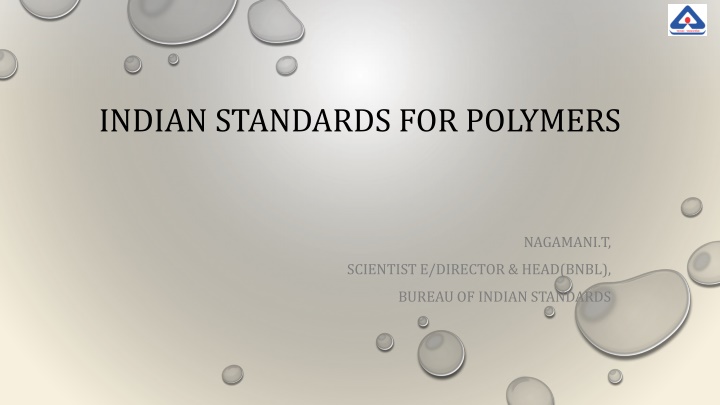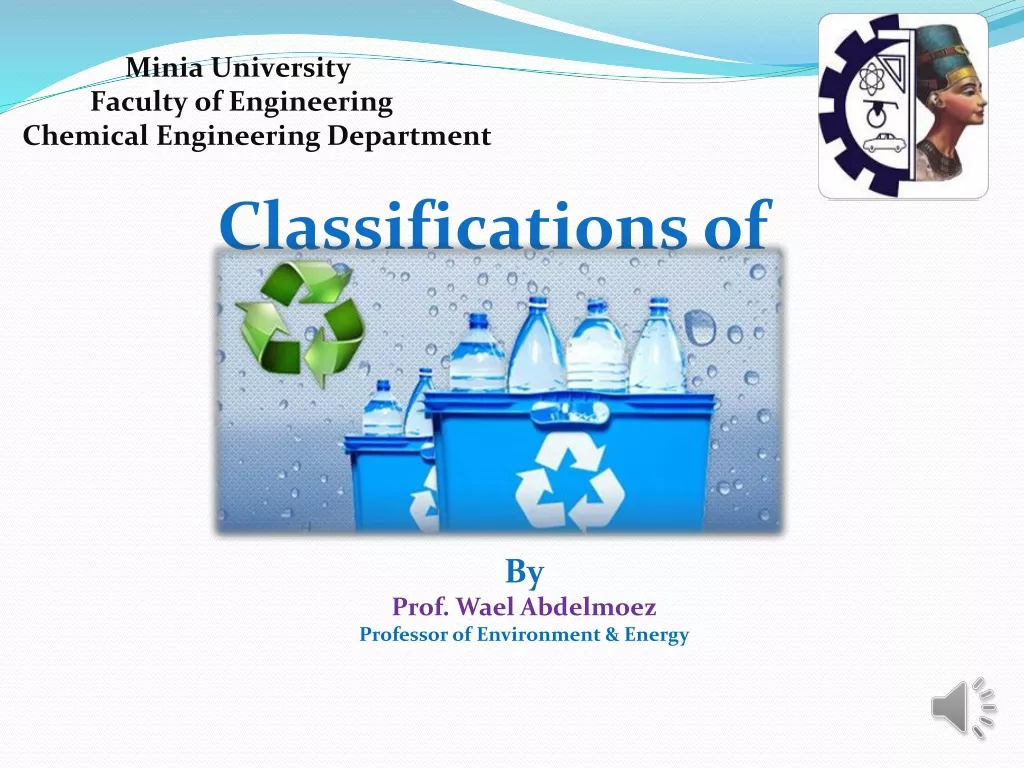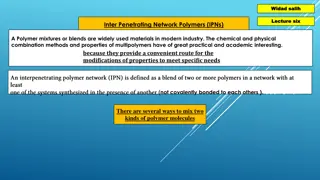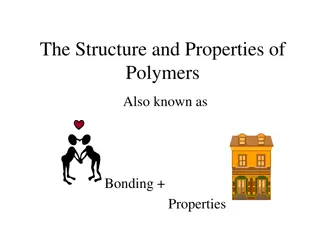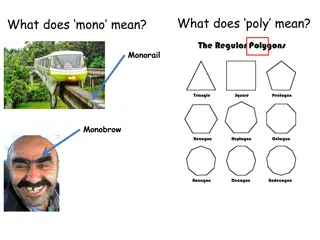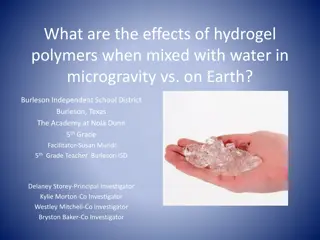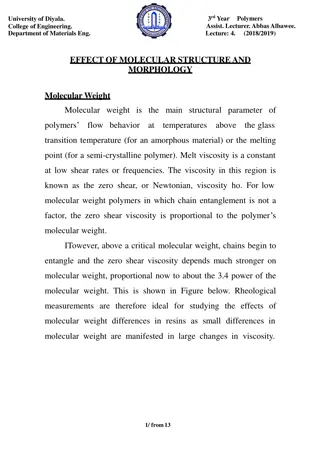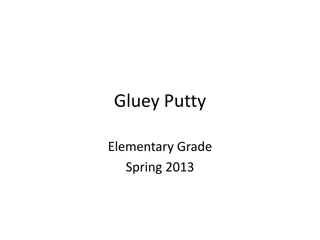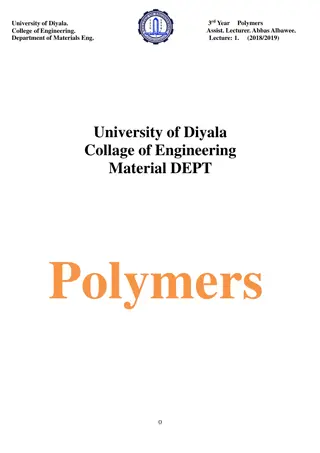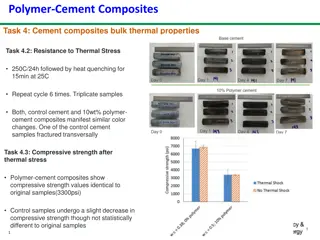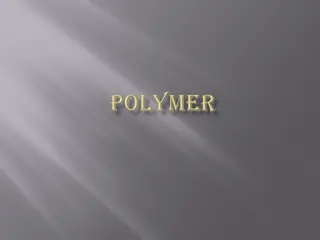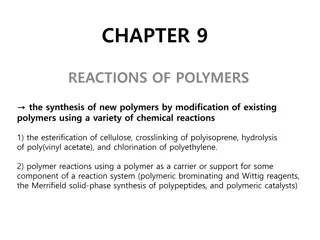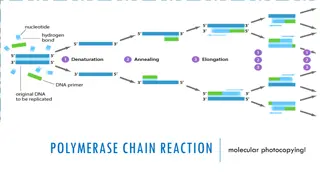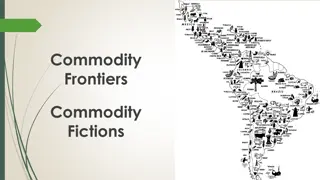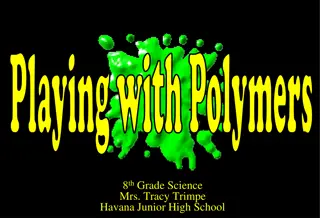Indian Standards for Polymers: Understanding Polymer Classification Based on Properties and Functions
Polymer science encompasses a wide range of materials with varying physical properties and functionalities. This article delves into the Indian standards for polymers, exploring their classification based on physical structure, chemical reactions, functionality, and properties. Learn about the diverse types of polymers, their uses in different industries, and the importance of identifying and differentiating polymers to ensure their correct application.
Download Presentation

Please find below an Image/Link to download the presentation.
The content on the website is provided AS IS for your information and personal use only. It may not be sold, licensed, or shared on other websites without obtaining consent from the author.If you encounter any issues during the download, it is possible that the publisher has removed the file from their server.
You are allowed to download the files provided on this website for personal or commercial use, subject to the condition that they are used lawfully. All files are the property of their respective owners.
The content on the website is provided AS IS for your information and personal use only. It may not be sold, licensed, or shared on other websites without obtaining consent from the author.
E N D
Presentation Transcript
INDIAN STANDARDS FOR POLYMERS NAGAMANI.T, SCIENTIST E/DIRECTOR & HEAD(BNBL), BUREAU OF INDIAN STANDARDS
POLYMER Coined from two greek words Poly means many and Mer means unit or part By definition, POLYMER means A large molecule (macromolecule) built up by repetitive bonding (covalent) of smaller molecules (monomers) Can be classified based on the number of functional groups, physical structure and also based on the type of chemical reaction they are formed by as well as based on physical properties Polymers exists in every field, with vast varieties and new possibilities always exist .More scope for R&D 2
CLASSIFICATION OF POLYMERS Based on physical structure Based on chemical reaction Based on functionality Monofunctional Linear Polycondensation reaction Bifunctional Crosslinked Addition reactions (steps, chains and ionic) Trifunctional Branch chained 3
CLASSIFICATION BASED ON PHYSICAL PROPERTIES Cannot be reused decomposes on heating-heat resistant Phenol-formaldehyde, Urea-aldehydes, etc Can be melted repeatedly and reused Vinyls, PEs, PPs, cellulose derivates, etc Thermos etting Thermo plastics Resistant solids with elasticity Butadiene & its copolymers, silicones, thiokols, etc Elastom ers Threads having high tensile strength Polyamides, polyesters, polyurethanes, etc Fibers 4
DO YOU KNOW.. Polymers are generally colourless/transparent Most of these polymers are sold primarily as resins or pellets or powder Polymer producers can be different from polymer material manufacturers A single type of polymer can be used in different industries for different purposes Polymers can be blended once again through various chemical processes 5
THEN, HOW TO DIFFERENTIATE & IDENTIFY POLYMERS Any colours to be added? Any additives to be added for gaining special properties? Any special tests for identifying different plastics? Or just to believe the resin manufacturer s claims???? There can be chances of mis-identification or getting wrong type of plastic pellets/ powder/ resin .Then How to identify what is the resin to be purchased and what are it s aimed usages???? 6
STANDARDS ARE SOLUTIONS FOR SUCH REPETITIVE PROBLEMS .. Indian standards for various plastic resins/pellets/powder are available These ISs are revised from time to time, as required by various users/ stakeholders, enabling their implementation They clearly mention the characteristic parameters that are specific for the polymers, i.E. Designated properties Apart from designated properties, the standards also include the information about Probable additives, colourants that will be mixed with resins for extruding or moulding purposes The combination of additives/ fillers/ compounds/reinforced materials that can be used for various end- uses Intended application of the polymer &/or Method of processing The above details forms basis for classifying/coding various plastic pellets/resins/ powders . Which help end-user to choose right material for their intended application, for the required quality of output. 7
INDIAN STANDARDS ON PLASTICS PLASTICS SECTIONAL COMMITTEE, PCD12 - published around 141 Indian Standards 24 among them are for polymer materials only IS 2267(Part 1) - Polystyrene (PS) moulding and extrusion materials Part 1 designation system and basis for specification IS 2543 - Cellulose secondary acetate materials for moulding and extrusion - Specification IS 3389 - Urea-formaldehyde moulding materials - Specification IS 3669 - Melamine-formaldehyde moulding materials - Specification IS 6746 - Unsaturated polyester resin systems - Specification IS 7166 - Specification for cellulose secondary acetate flakes IS 7328 - Specification for polyethylene material for moulding and extrusion IS 10951- Specification for polypropylene (PP) materials for moulding and extrusion IS 13193 - Polyalkylene terephthalates PET and PBT for moulding and extrusion Specification IS 13463 - Polyamide 6 materials for moulding and extrusion Specification IS 13464 - Polyamide nylon 66 materials for moulding and extrusion Specification IS 14421 - Plasticizer esters Specification IS 14426 - Chlorinated paraffins cp Specification IS 14434 - Polycarbonate moulding and extrusion materials - Specification 8
IS 16591 (Part 1) - Plastics - Mixtures of polypropylene (PP) and polyethylene (PE) recyclate derived from PP and PE used for flexible and rigid consumer packaging Part 1 Designation system and basis for specification. IS 14635 (Part 1) - Fluoropolymer dispersions and moulding and extrusion materials Part 1 Designation system IS 16635 - Plastics - Post-consumer poly ethylene terephthalate pet bottle recyclates Part 1 Designation system and basis for specifications IS 17397(Part 1) - Plastics - Thermoplastic polyurethanes for moulding and extrusion Part 1 Designation system and specifications IS 17658 - Polyvinyl chloride PVC homopolymers Specification. IS 17659 - Polyester polyol - Specification IS 17077(Part 1) - Plastics - Acrylonitrile- butadienestyrene (ABS) moulding and extrusion materials Part 1 designation system and specifications IS 17927 (Part 1) - Plastics - Ethylene-vinyl acetate (EVA) moulding and extrusion materials Part 1 Designation system and specification IS 17928(Part 1) - Plastics - Poly methyl methacrylate (PMMA) moulding and extrusion materials Part 1 designation system and specifications IS 17988 - Chlorinated polyvinyl chloride (CPVC) resin - Specification IS 17992 - Superabsorbent polymer - Sodium polyacrylate resin for hygiene products Specification IS 18103 - Plastics - Polyacrylamide materials - Designation system and specification 9
POLYMERS IN CONTACT WITH FOOD STUFF IS 10142 - Polystyrene crystal and high impact for its safe use in contact with foodstuffs pharmaceuticals and drinking water Specification IS 10146 - Specification for polyethylene for its safe use in contact with foodstuffs pharmaceuticals and drinking water IS 10151- Polyvinyl chloride (PVC) and its copolymers for its safe use in contact with foodstuffs pharmaceuticals and drinking water - Specification IS 10910 - Specification for polypropylene and its copolymers for its safe use in contact with foodstuffs pharmaceuticals and drinking water IS 11434 - Specification for ionomer resins for its safe use in contact with foodstuffs pharmaceuticals and drinking water IS 11704 - Specification for ethylene acrylic acid EAA copolymers for their safe use in contact with food - Stuffs pharmaceuticals and drinking water. IS 12247 - Specification for nylon-6 polymer for its safe use in contact with foodstuffs pharmaceuticals and drinking water. IS 12252 - Polyalkylene terephthalates, PET and PBT, their copolymers and list of constituents in raw materials and end products for their safe use in contact with foodstuffs and pharmaceuticals IS 13576 - Ethylene methacrylic acid (EMAA) copolymers and terpolymers for their safe use in contact with foodstuffs pharmaceuticals and drinking water Specification IS 13601 - Ethylene vinyl acetate (EVA) copolymers for its safe use in contact with foodstuffs pharmaceuticals and drinking water Specification IS 14971 - Polycarbonate resins for its safe use in contact with foodstuffs pharmaceuticals and drinking water Specification IS 14997 - Modified poly phenylene oxide ppo resins for its safe use in contact with foodstuffs pharmaceuticals and drinking water Specification IS 14999 - Melamine-formaldehyde resins for its safe use in contact with foodstuffs pharmaceuticals and drinking water - Specification 10
LISTS OF CONSTITUENTS IN POLYMERS IN CONTACT WITH FOOD STUFF IS 9833 - List of colourants for use in plastics in contact with foodstuffs and pharmaceuticals IS 10148 - Positive list of constituents of polyvinyl chloride (PVC) and its copolymers in contact with foodstuffs pharmaceuticals and drinking water IS 10149 - Positive list of constituents of styrene polymers in contact with foodstuffs pharmaceuticals and drinking water. IS 12248 - Positive list of constituents of nylon-6 polymer for its safe use in contact with foodstuffs pharmaceuticals and drinking water. IS 11435 - Positive list of constituents of ionomer resins for its safe use in contact with foodstuffs pharmaceuticals and drinking water IS 11705 - Positive list of constituents of ethylene acrylic acid (EAA) copolymers for their safe use in contact with foodstuffs pharmaceuticals and drinking water IS 13449 -Positive list of constituents of ethylene vinyl acetate (EVA) copolymers in contact with foodstuffs pharmaceuticals and drinking water IS 13577 - Positive list of constituents of ethylene methacrylic acid (EMAA) copolymers and terpolymers in contact with foodstuffs pharmaceuticals and drinking water. IS 14972 - Positive list of constituents of polycarbonate resins in contact with foodstuffs pharmaceuticals and drinking water IS 14996 - Positive list of constituents of modified poly phenylene oxide ppo in contact with foodstuffs pharmaceuticals and drinking water IS 14998 - Positive list of constituents of melamine- formaldehyde resins in contact with foodstuffs pharmaceuticals and drinking water IS 16621 - Positive list of constituents of polyethylene and polypropylene in contact with foodstuffs pharmaceuticals and drinking water IS 16738 - Positive list of constituents for polypropylene polyethylene and their copolymers for its safe use in contact with foodstuffs and pharmaceuticals. 11
CONTENTS IN AN INDIAN STANDARD FOR POLYMER MATERIAL FOR EXTRUSION AND MOULDING PURPOSES IS 7328 SPECIFICATION FOR POLYETHYLENE MATERIAL FOR MOULDING AND EXTRUSION 12
IS 7328 ... Polyethylenes are most commonly used polymers 1974 version of IS 7328 is for HDPE & IS 3395 for LDPE, which were merged into a single standard, IS 7328 Aligned designations with ISO 17855-1 : 2014 plastics polyethylene (PE) moulding and extrusion materials part 1: designation system and basis for specifications 13
CLASSIFICATION OF PE MATERIALS BLOCK 1 --- IS 7328 BLOCK 2 --- 1 For LDPE; 2 for LLDPE; 3 for HDPE; 4 for compounded materials; Co-monomer used - B for butene-1, H for hexene-1, O for octene-1 and P for propylene and Z for any other co-monomer BLOCK 3 --- Method of process or intended application (A to Z) followed by additives & supple ..mentary information (A to Z) BLOCK 4 --- MFI (A to H) and density (A to T) 14
COMPOUNDS CLASSIFICATION BLOCK 5 --- Filler or reinforcing material and it s physical form; and mass content of fillers & reinforcing materials 15
EXAMPLES A low density polyethylene (1) for production of blown film (F) having additive formulation of antioxidant (B) and no slip and no antiblock (E) with density at 23 C is 918.0 kg/m3 (B) and melt flow rate of resin at 190 C/2.16 kg (D) is 0.50 g/10 minutes (A) shall be designated as: Data Block Block 1 Block 2 Block 3 Block 4 Terminology IS 7328 1 FBE BDA Designation code IS 7328 1-FBE-BDA 17
EXAMPLES A linear low density polyethylene (with butene -1 co-monomer, B) based compound (4) for injection moulding application (M) having antioxidant (B), antistatic agent (J), with density at 27 C, 927.0 kg/m3 (M) and melt flow rate (190 C/2.16 kg) (D) of 25 g/ 10 minutes (E) and having chalk (K) filler in powder form (B) of 22 percent (20) Data Block Block 1 Block 2 Block 3 Block 4 Block 5 Terminology IS 7328 4B MBJ MDE KB20 Designation code IS 7328 4B-MBJ-MDE-KB20 18
ADDITIONAL PROPERTIES FOR PE MATERIALS INCLUDE MECHANICAL PROPERTIES Tensile strength; elongation; flexural modulus; tear strength; dart impact strength; izod/charpy impact strength; shore A or D hardness; coefficient of friction THERMAL PROPERTIES Head deflection temperature; Vicat softening point; brittleness temperature; oxidation induction time ELECTRICAL PROPERTIES Surface resistivity; volume resistivity; dielectric strength; dissipation factor; relative permittivity PERMEATION PROPERTIES Water absorption; environmental stress crack resistance; volatile content; gas permeability; oxygen gas transmission rate; water vapour transmission rate AGEING PROPERTIES Oven ageing; natural/artificial weathering OPTICAL PROPERTIES Haze and/or luminous transmittance; specular gloss; transparency; yellowness index and/or whiteness index; colour fastness to daylight; colour bleeding 20
PACKAGING AND MARKING Packed in suitable form Marking shall be: A) Name and type of the material, B) Designation code C) Net mass of the material, D) Batch number/ lot number, E) Month and year of manufacture of the material, and NOTE batch number/ lot number should reflect month and year of manufacture of the material. If not, it has to be printed separately as mentioned in (e). F) Name of the manufacturer and trade mark; if any; PACKAGING & MARKING -- Details remains same for all polymers 21
SPECIAL REQUIREMENTS OF POLYMER USED FOR MOLDING OR EXTRUSION ARTICLES IN CONTACT WITH FOOD STUFFS, PHARMACEUTICAL AND DRINKING WATER All additives used in the material meant for usage in contact with foodstuffs, pharmaceuticals and drinking water are given in IS 16738 Colourants as per IS 9833 When the products are used in contact with foodstuffs, pharmaceuticals and drinking water, its requirements with respect to the material shall also be met as per 3.3, 3.4 and 3.5 of IS 10146 These requirements include pigments and colourants, overall migration limits and heavy metals These are common requirements for all polymers used for molding or extrusion articles in contact with food stuffs, pharmaceuticals and drinking water 22
ANOTHER INDIAN STANDARD FOR RECAP OF THE CONCEPT ON CLASSIFICATION CODES OF POLYMERS IS 10951 SPECIFICATION FOR POLYPROPYLENE PP MATERIALS FOR MOULDING AND EXTRUSION 23
IS 10951 Scope is similar in most of these standards prescribes the designation system, requirements, methods of sampling and tests for polypropylene (PP) thermoplastics material. applies to the material ready for normal use in the form of powder, granules or pellets and to materials unmodified or modified by additives, fillers, etc applicable to all propylene homopolymers and to copolymers of propylene does not cover master batches Designated properties are MFI (IS 13360 (Part 4/Sec 1)/ASTM D1238) and flexural modulus (IS 13360 (Part 5/Sec 7)/ASTM D 790); and in some cases, includes Izod impact test also (IS 13360 (Part 5/Sec 4)/ASTM D 256) 24
CLASSIFICATION CODES Similar coding, with few distinguish changes For PP materials, Data Block 1 Block 2 Block 3 Block 4 IS 10951 Identification of the resin by its symbol and information about the composition of the polymer (see 3.3) Position 1: Intended application or method of processing (see 3.4). Positions 2 to 3: Important characteristics, additives and supplementary information (see 3.4). Designator properties (see 3.5) 25
For PP compounds. Data Block 1 Block 2 Block 3 Block 4 Block 5 Block 6 IS 10951 Identification of the Compounds by its symbol and information about the composition of the polymer (see 3.3) Position 1: Intended application or method of processing (see 3.4). Positions 2 to 3: Important characteristics, additives and supplementary information (see 3.4) Designator properties (see 3.5) Fillers or reinforcing materials and their nominal content (see 3.6) An optional sixth block may be added containing additional information 26
EXAMPLES A polypropylene homopolymers (1) intended for film extrusion (F), which is stabilized with antioxidant (B) and additionally slip and antiblock (H) is added having melt flow rate of 10 g/10 min (B) Data Block Block 1 Block 2 Block 3 Block 4 Terminology IS 10951 1 FBH B Designation code IS 10951-1-FBH-B 27
EXAMPLES A propylene compound (4) for injection moulding application (M), with nucleating agent (L) and impact modifier (S) having a melt flow rate of 3.5 g/10 min (A), flexural modulus of 1200 MPa (C) and an impact strength of 225 J/m (E). This is also modified with 15 percent talc (T) in powder form (D) Data Block Block 1 Block 2 Block 3 Block 4 Block 5 Terminology IS 10951 4 MLS ACE TD15 Designation code IS 10951-4-MLS-ACE-TD5 28
THANK YOU 30
